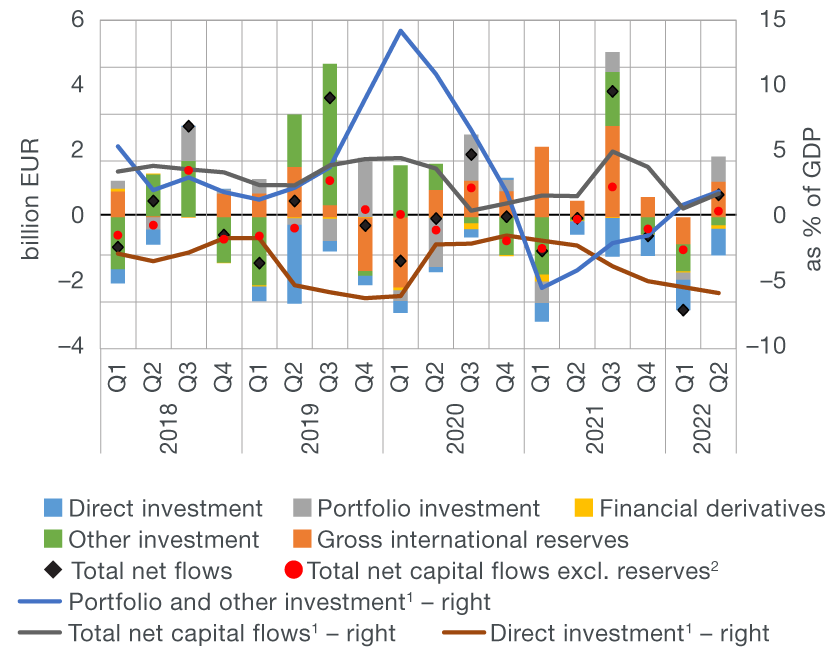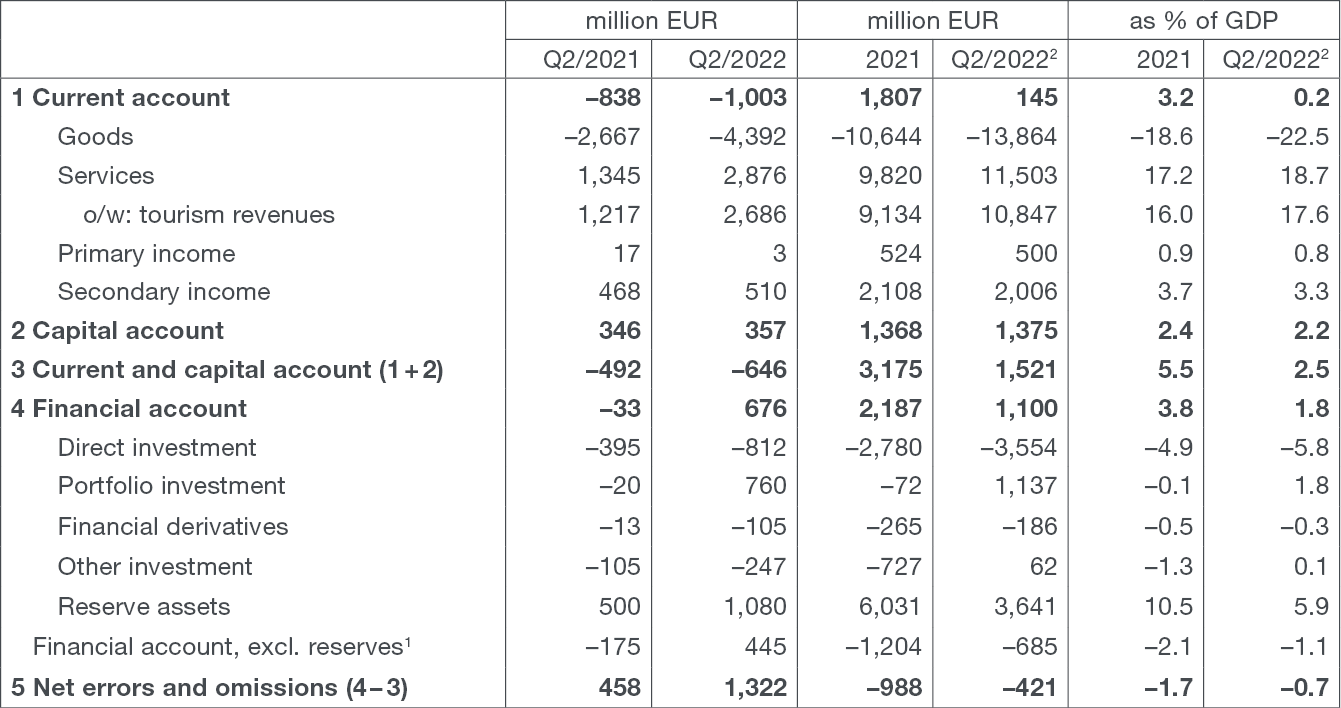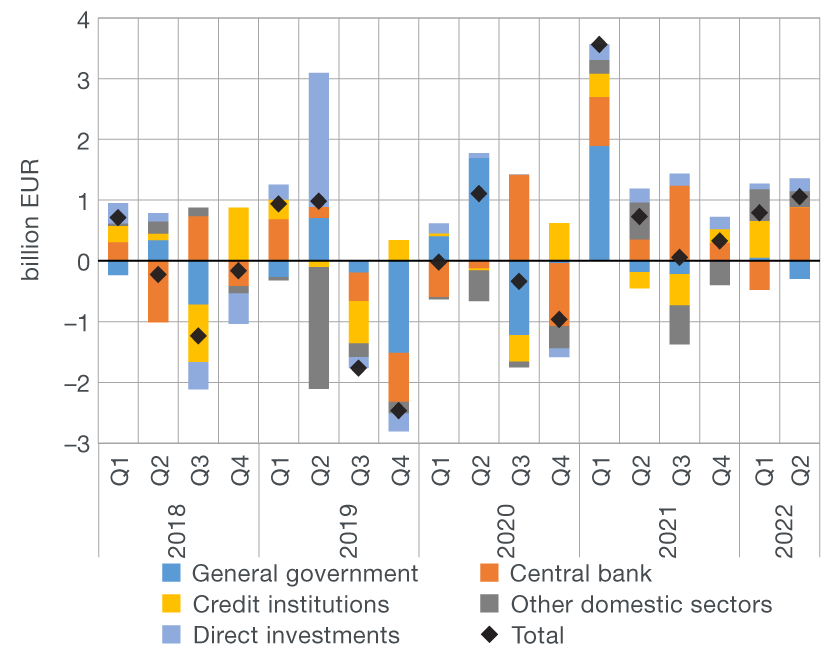From August 2023 the comments on statistics, a short description of selected, recently issued statistical data in the area of monetary statistics and the non-residents sector statistics, are no longer published. They are replaced by Statistical releases.
Comments on the balance of payments, gross external debt and the international investment position in 2Q 2022
The current and capital account of the balance of payments ran a deficit of EUR 0.6bn in the second quarter of 2022, which is an increase of EUR 0.2bn from the same period of the previous year. This resulted from the further deterioration of the foreign goods trade balance, which is to a large extent related to the stronger net imports of energy, partly reflecting the increase in their prices. If the last four quarters are observed, the surplus in the current and capital account in the period up to the end of June 2022 totalled 2.5% of GDP, which was 3.1 percentage points less than in the entire 2021.
Gross external debt stood at 75.8% of GDP at the end of June, decreasing by 1.5 percentage points from the end of March 2022, thanks to nominal GDP growth. In the same period, the ratio of net international investment position to GDP improved from –36.4% of GDP to –32.8% of GDP.
The current and capital account of the balance of payments ran a deficit of EUR 0.6bn in the second quarter of 2022, which is a deterioration in the balance of EUR 0.2bn from the same period of the previous year (Figure 1a). This is a result of the strong increase in the foreign goods trade deficit, while unfavourable developments were largely mitigated by an increase in the net exports of services. At the same time, the surplus in the secondary income and capital transaction accounts increased slightly, while the balance in the primary income account did not change significantly (Table 1). If the last four quarters are observed, the surplus in the current and capital account in the period up to the end of June 2022 totalled 2.5% of GDP, which was 3.1 percentage points less than in the entire 2021.
Foreign goods trade continued to grow in the second quarter of 2022 at exceptionally high nominal rates of growth, which largely reflect the continued rise in the prices of energy and other raw materials on the global market resulting from disruptions in global value chains, further intensified by the war in Ukraine. Total exports of goods grew at 40.5% in annual terms, while imports increased even more noticeably, by 50.5%, resulting in an exceptionally strong deficit increase (of 64.7% or EUR 1.7bn). However, the strong deterioration in goods trade was greatly mitigated by the further rise in the net exports of services (of EUR 1.5bn), mainly owing to growing revenues from tourist spending of foreign guests. The rise in tourism revenues reflects the continued recovery in volume indicators on the one hand, but also the noticeable increase in the prices of accommodation and food service activities on the other. Net exports of other services not related to tourism, particularly transportation services, increased to a much lesser extent.
The balance in the primary income account remained at the same level as in the second quarter of 2021 considering that the rise in net revenues from compensation of persons temporarily employed abroad was fully offset by higher net expenditures on direct equity investments, i.e. by the higher profit of foreign-owned enterprises, primarily in accommodation activities, motor vehicles trade and oil industry. At the same time, the overall surplus in the secondary income and capital transaction accounts increased slightly (by EUR 52.6m) from the same period in the previous year, primarily owing to a rise in net revenues from personal transfers.
Figure 1 Balance of payments
| a) Current and capital account | b) Financial account |
 |
 |
1 Sum of the last four quarters.
2 Excluding the change in the gross international reserves and foreign liabilities of the CNB.
Note: In the figure showing the financial account, the positive value denotes net capital outflow abroad and the negative value denotes net capital inflow.
Source: CNB.
A net capital outflow of EUR 0.7bn was recorded on the financial account of the balance of payments in the second quarter of 2022, while in the same period in 2021, a balanced financial account balance was recorded. The net capital outflow was mainly due to the increase in the foreign assets of credit institutions and banks’ funds within the TARGET2 system.[1] In addition, net liabilities in the portfolio investment account went down as a result of a noticeable decrease in government foreign liabilities arising from long-term debt securities due to transactions in the secondary market. On the other hand, funds received from the EU budget greatly exceeded the amount of funds distributed to end users and net liabilities arising from foreign direct investment rose.
A noticeable net inflow of foreign direct investments (of EUR 0.8bn) seen in the second quarter of 2022 was primarily a result of new equity investments in Croatia, which were significantly higher than in the same period of the preceding year, and were mostly linked to the automotive industry and the real estate sector. Increased debt liabilities to affiliated enterprises abroad and the retained earnings of banks and enterprises in foreign ownership also contributed to the net inflow of foreign direct investments, although to a slightly smaller extent.
Funds received from the EU budget, which greatly exceeded the amount of funds distributed to end users, contributed the most to the net capital inflow in the other investment account (of EUR 0.2bn). Moreover, central bank liabilities increased as a result of the increased volume of repo transactions, which have a neutral impact on the overall financial account balance because they simultaneously raise gross international reserves by the same amount (see note in Table 1). At the same time, assets of credit institutions grew significantly, as well as central bank assets as a result of the increase in bank assets within the TARGET2 system.
A noticeable increase in gross international reserves (of EUR 1.1bn) seen in the second quarter resulted from the increase in the volume of repo transactions mentioned above and, to a significantly smaller extent, to the increase in government deposits with the CNB. Gross international reserves thus stood at EUR 25.2bn at the end of June 2022, having risen by 4.9% from the end of March.
Table 1 Balance of payments

1 Excluding the change in the gross international reserves and foreign liabilities of the CNB. The investment of a portion of international reserves in reverse repo agreements results in a simultaneous change in CNB assets (recorded in the reserve assets account) and liabilities (recorded in the other investment account) and thus has a neutral impact both on changes in the central bank’s net foreign position and the overall financial account balance.
2 Sum of the last four quarters.
Note: The positive value of financial transactions denotes net capital outflow abroad and the negative value denotes net capital inflow.
Source: CNB.
The gross external debt stood at EUR 46.7bn at the end of June 2022, up by EUR 1.1bn from the end of March 2022 (Figure 2a). Central bank debt increased the most (by EUR 0.9bn) due to the increase in the volume of repo transactions mentioned above; the debt of other domestic sectors, including their liabilities to affiliated creditors, went up as well, although to a somewhat lesser extent (by EUR 0.5bn). In contrast, general government debt decreased (by EUR 0.3bn) while the debt of credit institutions remained virtually unchanged. Despite the growth in debt in absolute terms, the strong increase in nominal GDP in the second quarter resulted in the improvement of the relative indicators of gross external debt by 1.5 percentage points from the end of March, so that at the end of June 2022, debt stood at 75.8% of GDP (Figure 2b).
Figure 2 Gross external debt
| a) Change in gross external debt | b) Stock of gross external debt |
 |
 |
Note: Changes in gross external debt are a result of net transactions of domestic sectors and exchange rate and other adjustments.
Source: CNB.
The growth in gross external debt coincided with a significantly stronger increase in debt claims of domestic sectors (primarily central bank and credit institutions’ assets) and thus led to a reduction in net external debt of EUR 1.6bn in the second quarter. Net external debt stood at EUR 3.3bn (5.4% of GDP) at the end of June 2022, down by 2.9 percentage points from March 2022.
The fall in net external debt led to an improvement in the net international investment position, from EUR –21.5bn at the end of March 2022 to EUR –20.2bn at the end of June. The net external position of all domestic sectors improved, primarily that of the central bank and credit institutions (Figure 3a). Accordingly, the relative indicator of the net international investment position improved to –32.8% of GDP at the end of June from –36.4% of GDP at the end of March 2022 (Figure 3b).
Figure 3 International investment position (net)
| a) Position by sector | b) Relative indicator by type of investment |
 |
 |
Note: The international investment position (net) equals the difference between domestic sectors' foreign assets and liabilities at the end of a period. The negative value of the net international investment position indicates that foreign liabilities of Croatian residents are greater than their foreign assets. Included are assets and liabilities based on debt instruments, equity investments, financial derivatives, and other instruments. Figure 3b includes financial derivatives and other liabilities in the net debt investment position.
Source: CNB.
Data revision
Data on the balance of payments, gross external debt and the international investment position have been revised for the previous periods. For more details see: External statistics revision
Detailed balance of payments data
Detailed gross external debt data
Detailed data on the international investment position
-
Banks’ funds within the TARGET2 system account for the central bank’s foreign assets, but they are not part of gross international reserves. ↑
